TikTok originated as a clip-sharing app where users could create 15-second videos.
Now, with over 1 billion active users who upload everything from comedy sketches to makeup tutorials, TikTok has become one of the most popular social media platforms.
It’s also becoming a promising marketing channel for businesses to reach new audiences.
On the other hand—
TikTok has also been criticized for its privacy practices, security issues, potential to spread disinformation, and promote harmful content. However, the platform is too big to just ignore or dismiss at this point.
Let’s crunch some numbers and look at what the data says about TikTok and its users.
In this article:
- How many people are on TikTok
- User demographics
- Average time spent on TikTok
- Positive and negative impacts of the platform
- Controversies and dangerous challenges
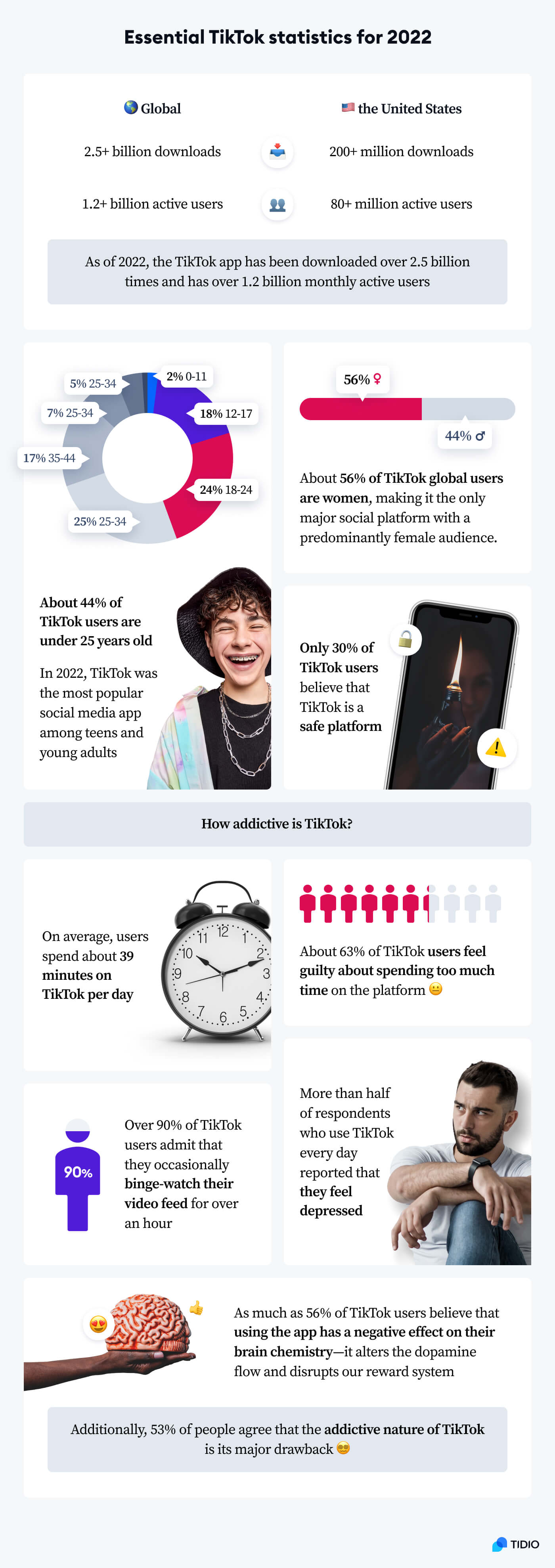
How long has TikTok been around?
TikTok was originally released in September 2016 as Douyin in China. The international version of the app was then released globally by ByteDance (TikTok’s parent company) one year later, in September 2017. Since then, TikTok has been downloaded over 2 billion times and is currently the most downloaded app in the world.
How popular is TikTok?
There is no doubt that TikTok has become one of the most important social media apps in recent years. In fact, the growing popularity of TikTok has had a significant impact on the way people consume content and how they interact with each other.
Following TikTok’s success, many other platforms started to introduce features such as short-form videos (e.g. Facebook/Instagram Reels), in order to keep up with the competition.
So, just how popular is TikTok?
1. The TikTok app has been downloaded over 2 billion times
The majority of TikTok downloads (over 90%) come from Android device users. The app has been downloaded over 2 billion times on Android alone and is available in over 150 markets.
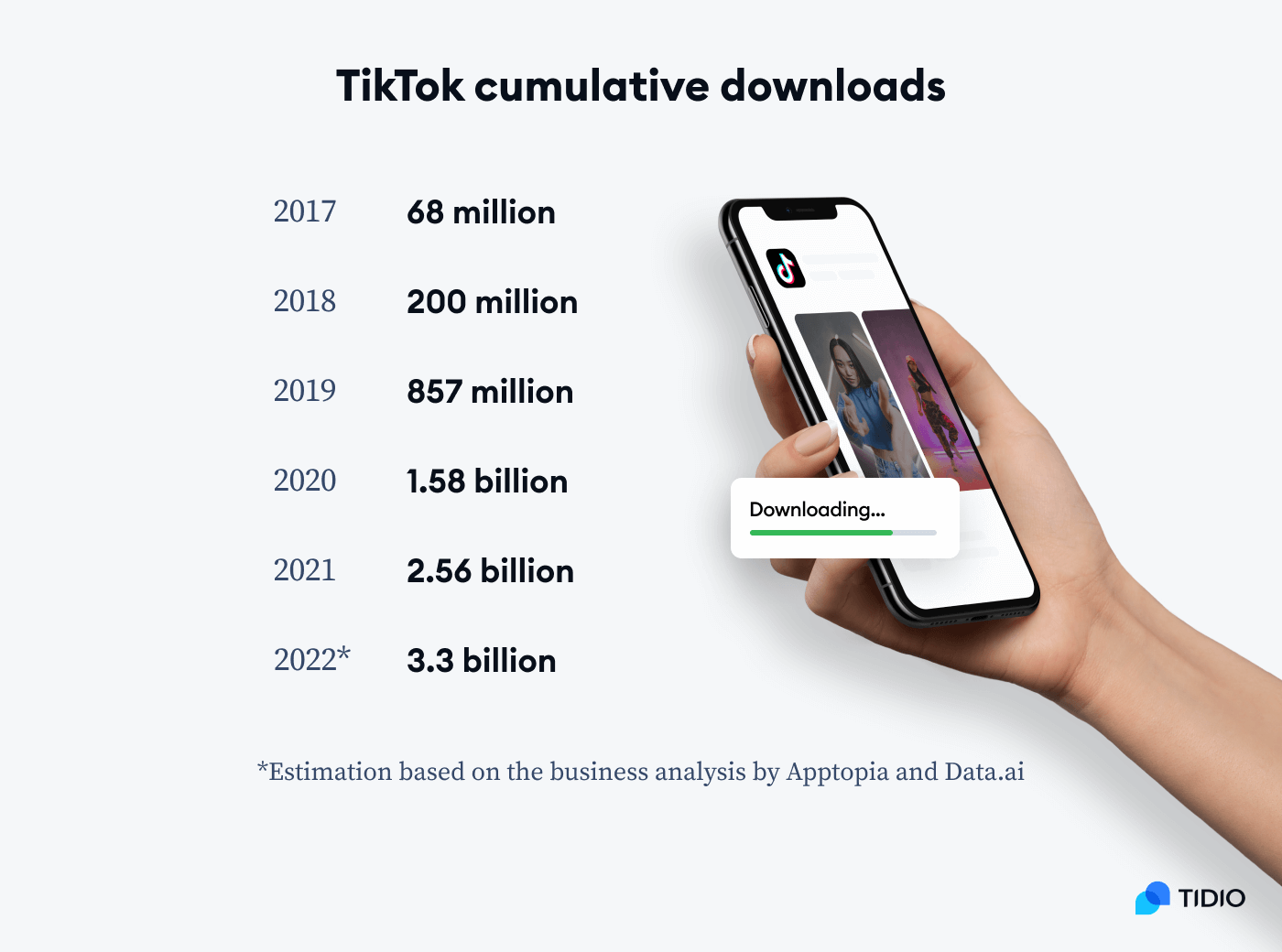
Still, in 2022, TikTok was the most downloaded iPhone app as well. The disproportion between Android/Apple installations is due to the lower popularity of Apple devices outside the Western markets. It is worth noting that TikTok is extremely popular in Asia. The Chinese version of TikTok (Douyin) has about 700 million users.
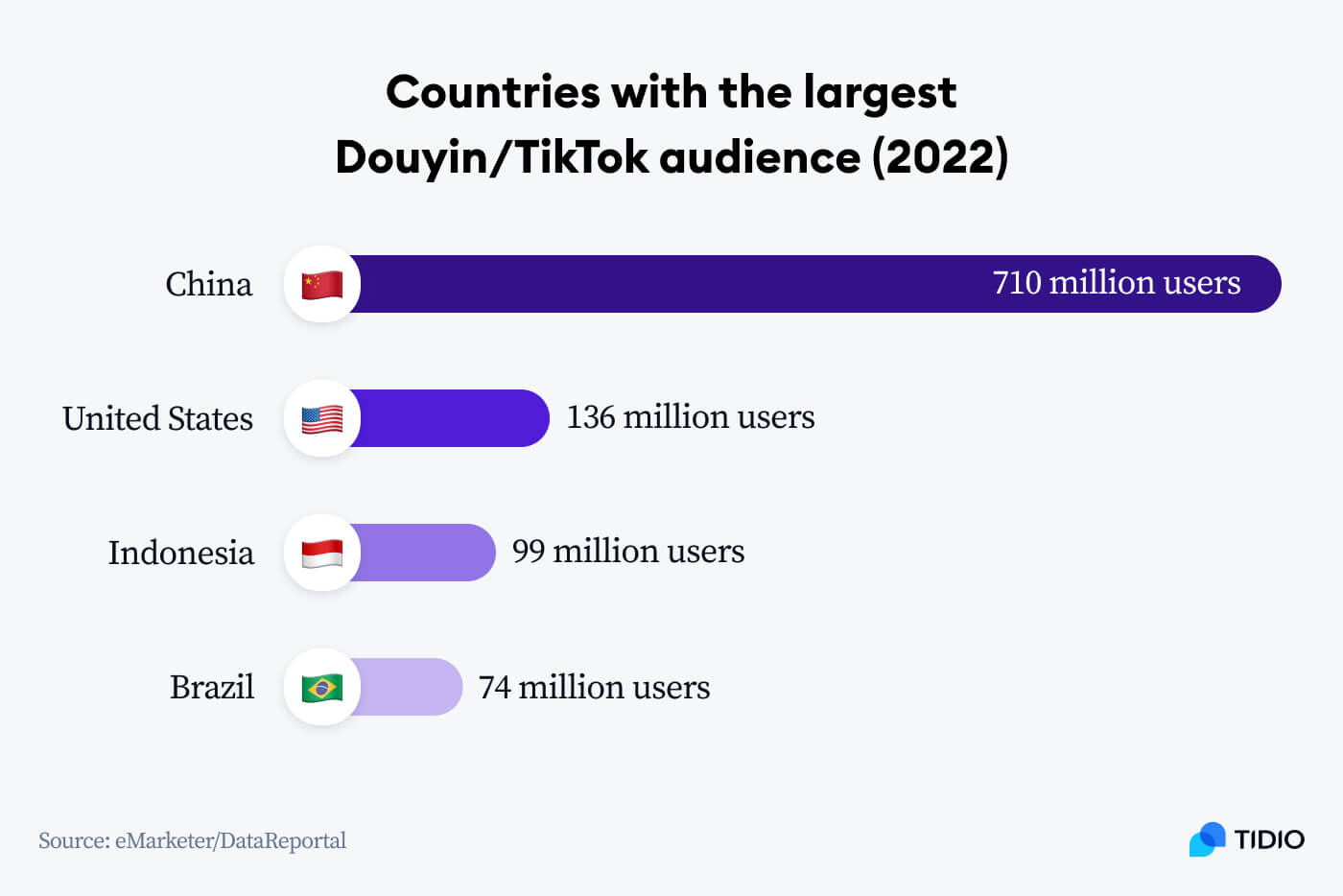
2. TikTok is used by 1.2 billion users at least once a month

While the number of installations of the TikTok app is impressive, it should be remembered that not everyone uses it regularly. Also, some users have multiple accounts. Still, there are around 1.2 billion active TikTok accounts used at least once per month. According to various reports, it was expected to reach between 1.6 and 1.8 billion by the end of 2022.
(Source: CNBC/App Annie Intelligence)

TikTok user statistics
The app is used by people of all ages, from young children to adults. However, the majority of users are teenagers and young adults. It’s not surprising, as TikTok is a very visual platform that is perfect for short, creative videos. This type of content is very popular with younger audiences.
Let’s take a closer look at TikTok demographics.
3. About 44% of TikTok users are under 25 years old
The young adult market is a huge draw for businesses and brands that want to target this age group. They are generally considered to be more engaged with social media and more likely to purchase products or services online. This makes them a very lucrative market for companies looking to expand their customer base through TikTok.
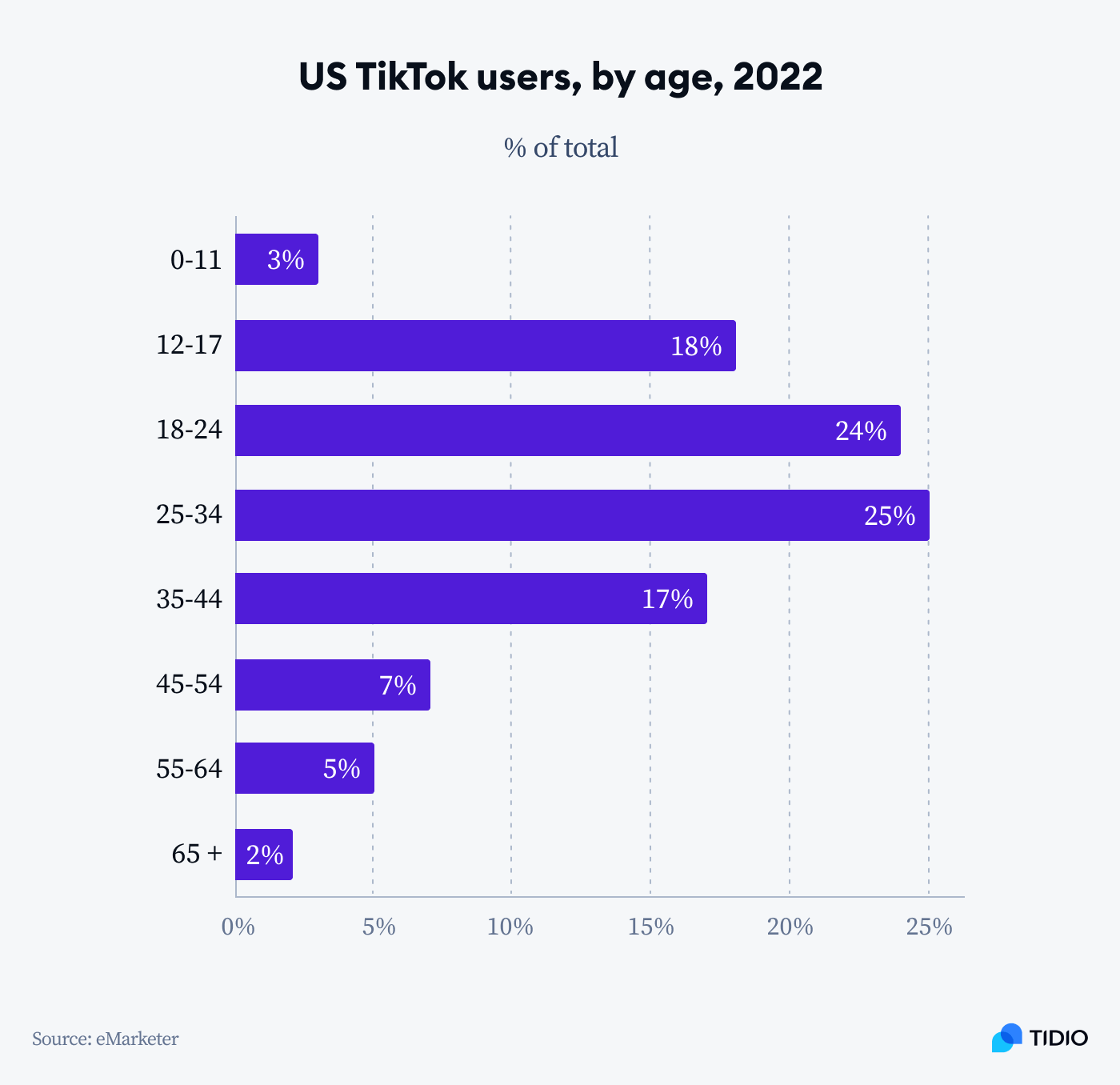
4. About 67% of US teenagers declare that they use TikTok
According to a survey by Pew Research Center, 67% of US teenagers aged 13 to 17 use TikTok. Officially, the app is intended for those aged 13 and over, but there is no age verification process, so anyone of any age can sign up and use TikTok. That’s why it’s hard to say how many younger children are using TikTok. Some estimate that as much as a third of TikTok users in the US are under the age of 14.
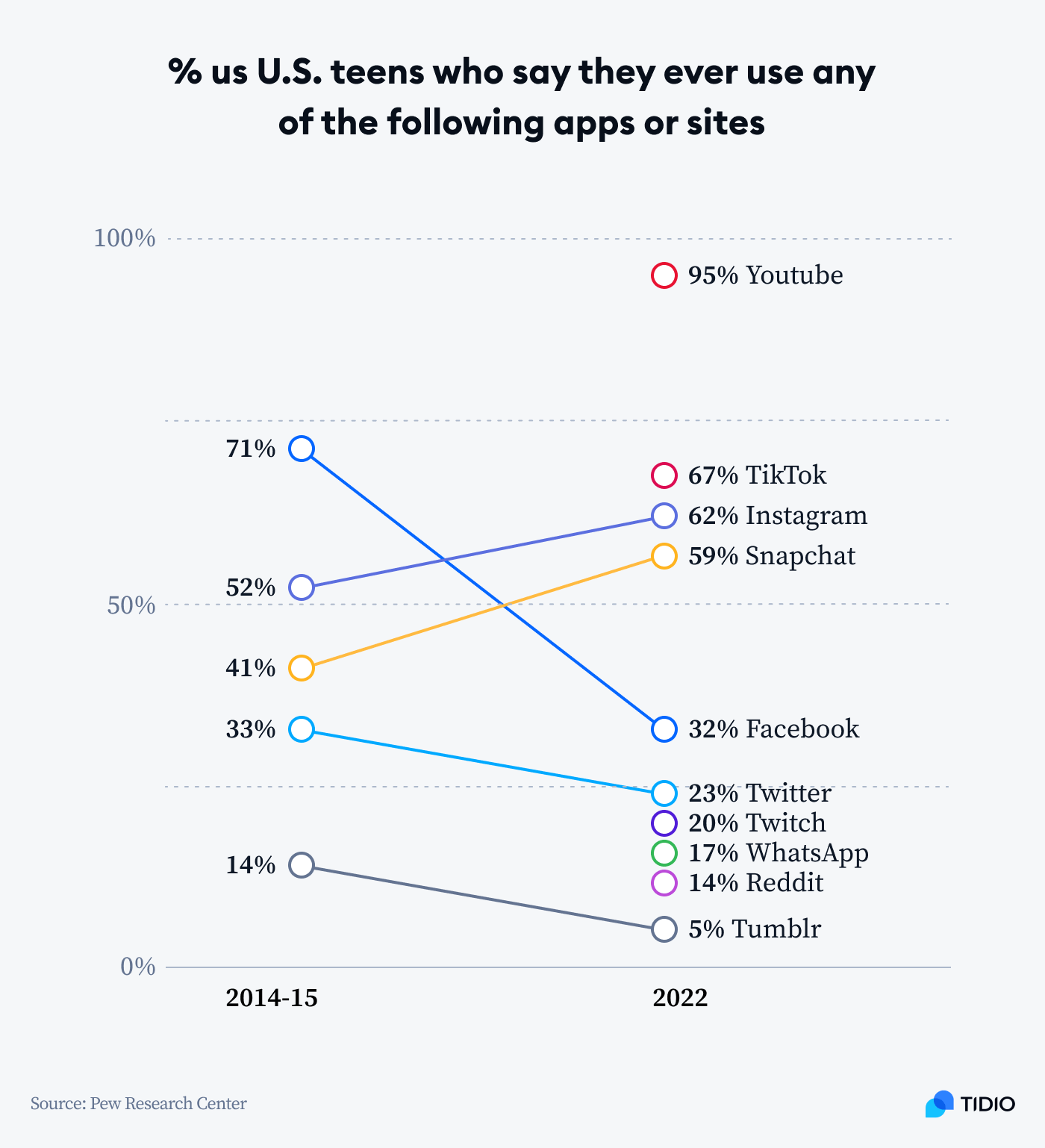
5. About 56% of TikTok global users are women and girls
This makes TikTok the only major social platform with a predominantly female audience. TikTok has a pronounced female profile, with the majority of active users being women.
On top of that, the activity rate of female users on the platform is also higher.
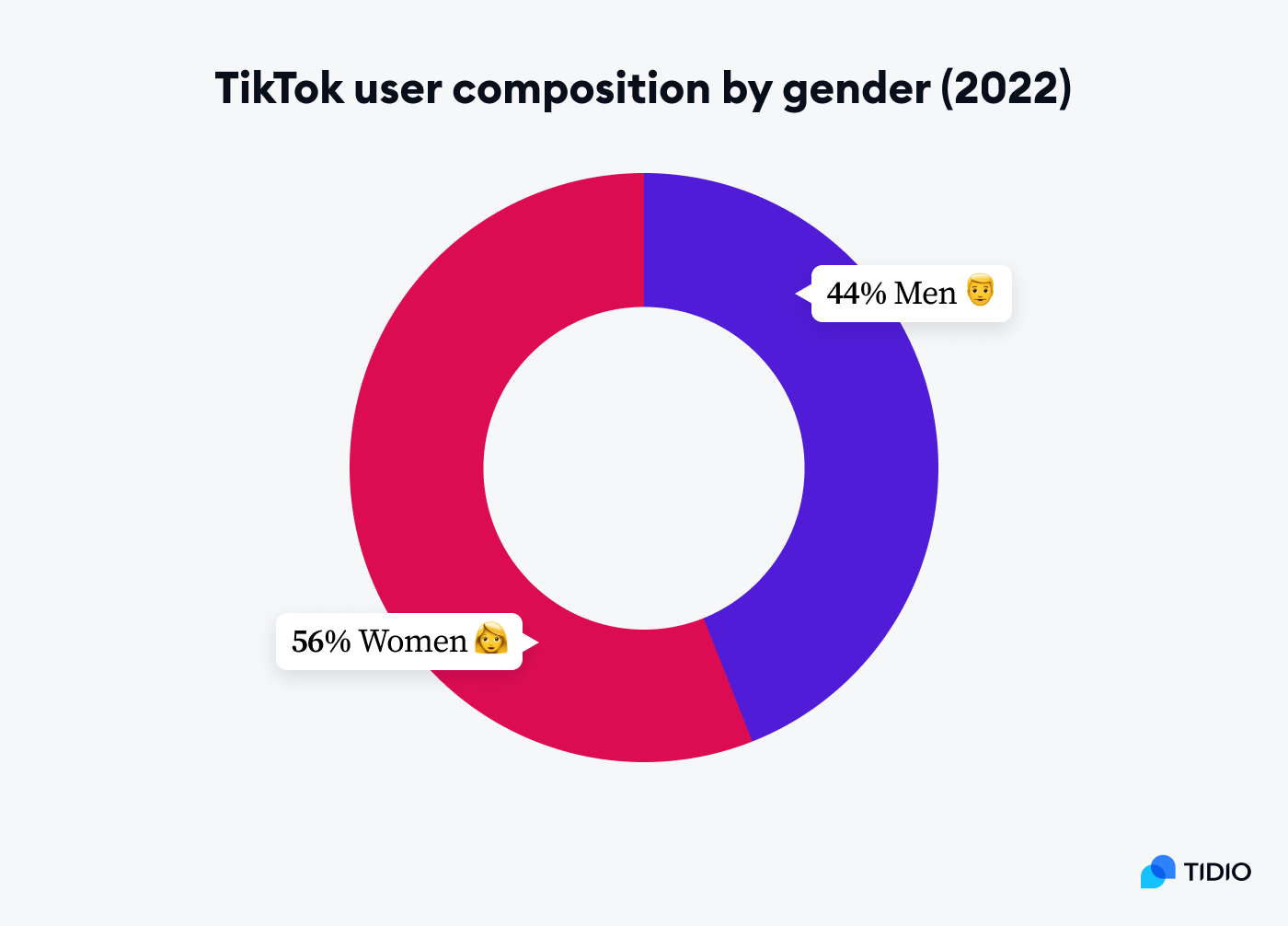
TikTok is the fastest-growing social app among women in the US. Not only are they more willing to actively upload and share videos on the app, but they also use it on a daily basis.
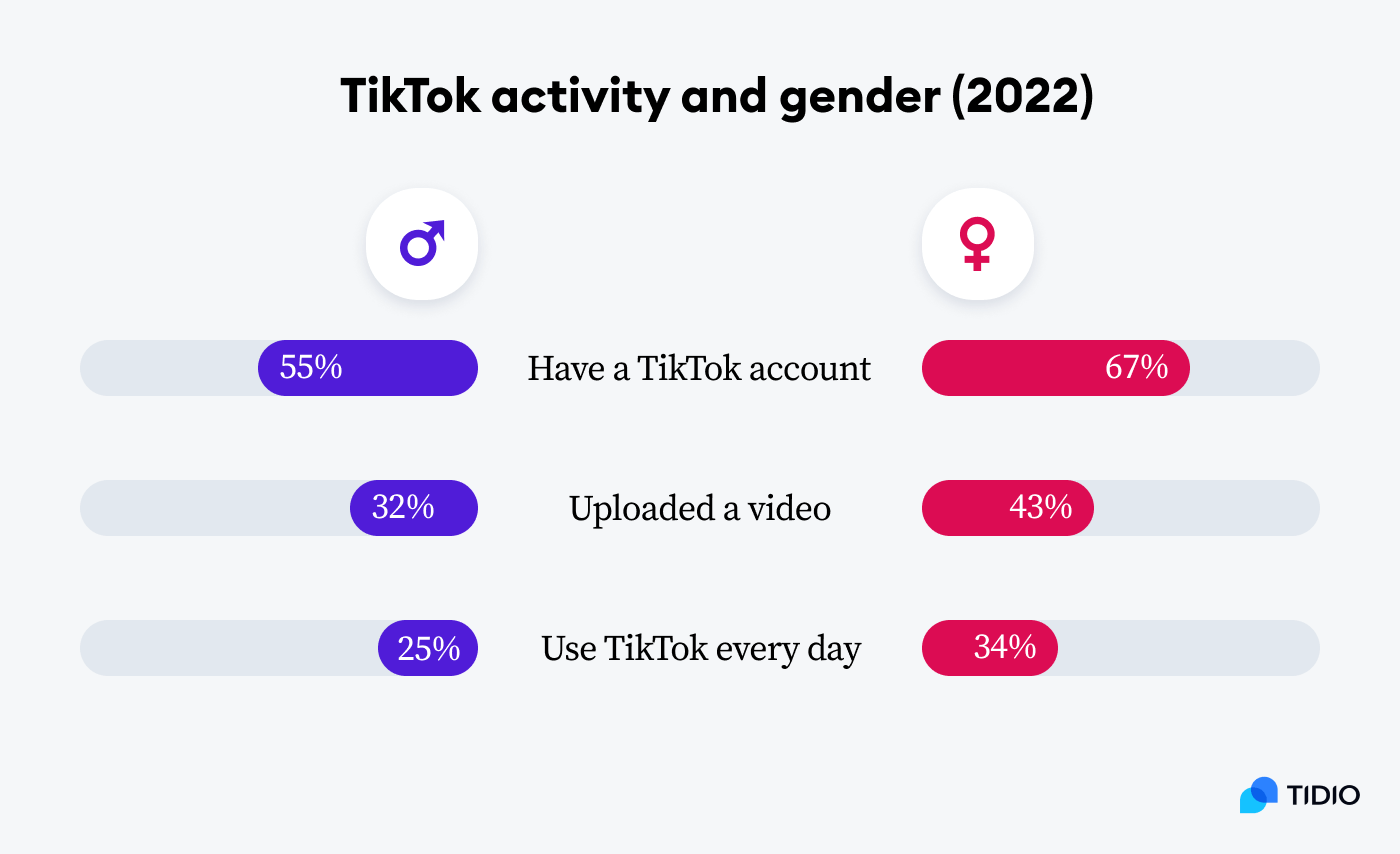
Many TikTokers focus on creating quality content, rather than just trying to be funny. And some categories, such as well-being, tutorials, and videos about making art, have done very well on the platform. This content resonates with the female audience that TikTok is trying to attract.

Some well-known TikTok creators, such as Rachel Levin, have built large followings by posting videos about makeup and beauty tips. And while many of the platform’s most popular users are teenagers, there is also a growing number of adult women who are finding success on TikTok.
6. About 48% of Gen Z respondents use TikTok on a daily basis
According to our original research, about 48% of Gen Z respondents who have a TikTok account use the app daily. This is likely due to the fact that TikTok is an incredibly addictive and engaging platform that offers a never-ending stream of short, entertaining pieces of content.
(Source: Tidio)
This brings us to another important question—
How much time do people spend on TikTok?
TikTok’s community is incredibly creative, with users constantly coming up with new trends and challenges. But the amount of time spent on TikTok and other social media apps can be a cause for concern, especially for parents of teenagers.
7. The average user spends about 39 minutes on TikTok per day
For a relatively new app, this is a significant amount of time. In comparison, people spend about 34 minutes on Facebook each day.
Interestingly, this does not mean watching videos for 40 minutes straight. Instead, most users use TikTok a couple of times a day, over several 10-15 minute sessions.
(Source: eMarketer)
8. About 40% of Gen Z spends more than three hours per day on TikTok
As we mentioned before, TikTok is incredibly popular with Gen Z-ers, who are using it to watch funny videos, learn new dance moves, and follow their favorite celebrities. TikTok offers a unique and immersive experience that seems to push all the right buttons for this demographic.
(Source: Front Office Sports)

9. About 63% of TikTok users feel guilty about spending too much time on the platform
Interestingly, active participants of the TikTok community who upload videos themselves have more regrets about spending time on the platform. About 70% of them feel guilty, compared to only about 50% of the passive users who only watch TikTok videos, without creating any content themselves.
(Source: Tidio)
10. Over 90% of TikTok users admit that they occasionally binge-watch TikTok’s video feed for over an hour
The short video format keeps user engagement rates high, while the algorithm ensures that viewers see content that is tailored to their interests. TikTok has become a popular way to procrastinate, with many people using it as a way to avoid studying or doing work. Some research papers suggest that the constant flow of new videos and the need to keep up with trends can lead to users feeling overwhelmed and stressed.
(Source: Tidio)
11. Almost 54% of respondents who use TikTok every day reported that they feel depressed
This figure is significantly higher than the result among the other respondents. Additionally, 42% of TikTok users claim that they have problems with their sleep. Another 14% reported poor performance at school or work.
(Source: Tidio)
TikTok is designed to be a highly entertaining platform. Users are constantly bombarded with fun, creative content that can be addictive. This constant stream of entertaining content can make it difficult for users to focus on anything else.
This begs the question: is being on TikTok really worth it?
For some, the answer is a resounding yes. After all, the app does have its fair share of benefits. But for others, the cons outweigh the pros.
Let’s explore both sides and see what our survey participants had to say on this matter.
Positive and negative impact of TikTok
For some, TikTok just passes the time when there’s nothing else to do. For others, it’s a new way to connect with friends and family or an outlet to express themselves creatively. Some people hope to find fame or validation by trying to record viral videos. But for businesses, TikTok is quickly becoming a powerful marketing tool.
12. In the US, TikTok’s return on ad spend (ROAS) is 14% higher than all other digital paid channels
In some European countries, such as France, Spain, or Germany, this number is even higher, with a 64% increase compared to paid campaigns on Instagram, Facebook, or Google. TikTok’s algorithms are very good at matching ads with users. This results in a much higher conversion rate for advertisers on TikTok.
(Source: TikTok Marketing Science/Nielsen)
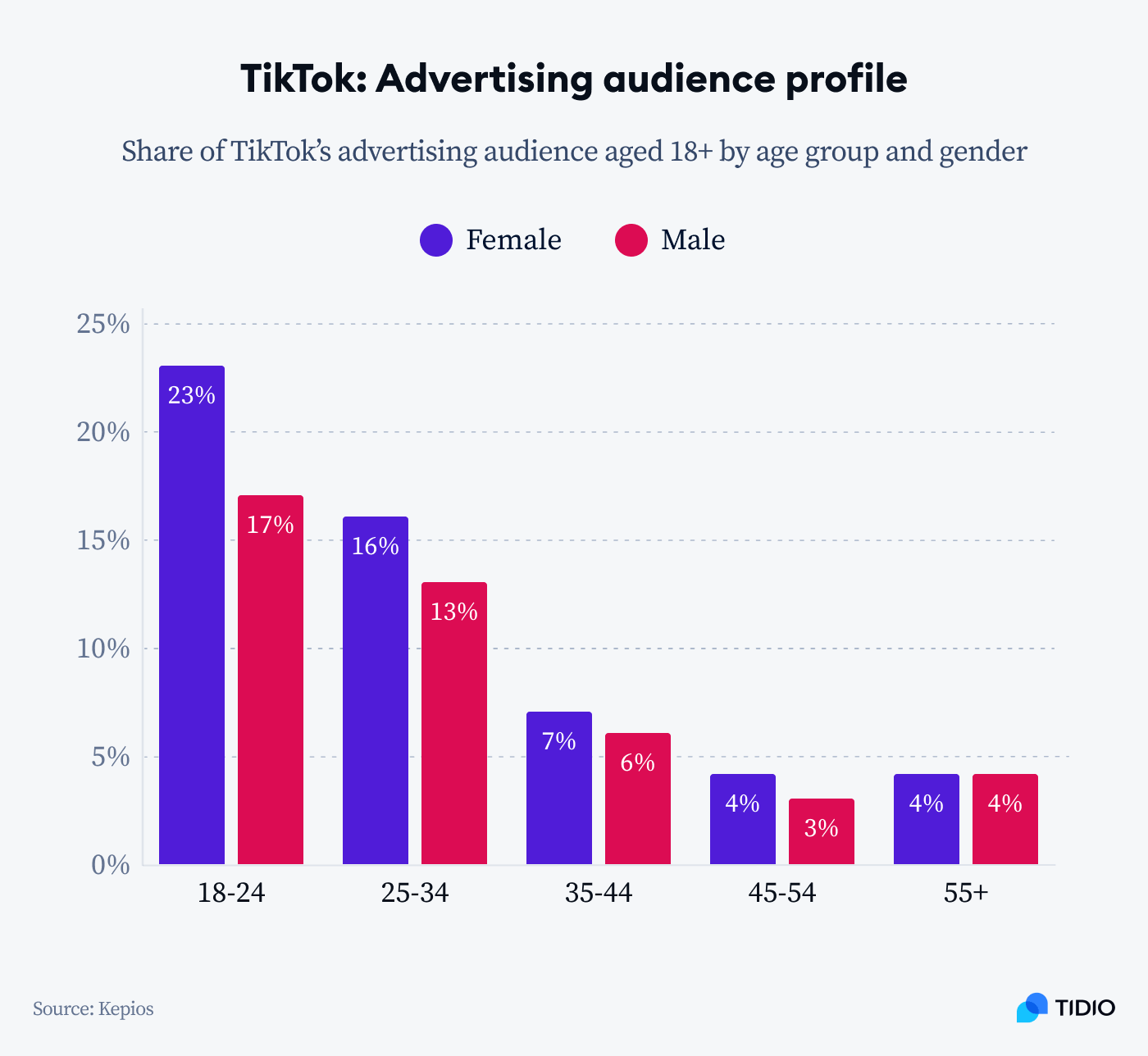
Additionally, TikTok offers a very targeted audience: young people who are actively looking for new and interesting content. That’s why TikTok marketing is a promising way to reach out to this customer segment.
The platform is also a real influencer marketing hub. You can use TikTok to build a following and create a community around your brand with the help of social media influencers. And if you don’t mind bending the rules, you can even use TikTok bots, similar to Instagram bots, to automate some marketing activities.
While TikTok is an interesting opportunity for marketing, it’s important to remember why it’s being used by young people in the first place: to be entertained. This means that your marketing content needs to be creative and engaging in order to be successful.
13. As much as 70% of people admit that the single biggest reason for using TikTok is entertainment
This is understandable, given the fact that TikTok is meant to be an entertainment platform first and foremost. However, about 32% of our respondents believe that there could also be some educational merits to the platform. Another 20% think that TikTok can be a good source of news and information.

Interestingly, improving mental health was least likely to be perceived as one of the potential advantages of TikTok. Only 10% of respondents believed that it can actually help people with their mental well-being. At the same time, 70% point out that TikTok is entertaining.
This is likely due to the fact that TikTok is mostly seen as a funny diversion, rather than a serious tool for improving mental health. However, there is potential for TikTok to be used in more positive ways to help people and their mental health. For example, the platform could be used to raise awareness of mental health issues and provide information on how to get help.
Still, more people are likely to perceive TikTok as a source of mental health problems than a solution to them. A study published by JAMA found that TikTok use was associated with lower self-esteem and increased anxiety and depression symptoms. While TikTok has the potential to connect people, it can also amplify feelings of disconnection.
14. About 53% of people believe that the addictive nature of TikTok is its major drawback
The addictive nature of TikTok has led to some concerns being raised about the app. Some worry that it’s a waste of time, while others believe that it could be harmful to young people’s mental health. Many respondents are also worried that TikTok could be used to spread misinformation. This is a valid concern since social media play a big role in the spread of fake news.

(Source: Tidio)
Many respondents also believe that using TikTok can lower our attention span. Even the users of the platform themselves agree that TikTok disrupts our neurological reward system.
15. Some 56% of TikTok users suspect that the app has a bad effect on our brain chemistry (dopamine flow)
We’ve compared the opinion polls of the users versus people who don’t use TikTok and found that the majority of our sample have some serious reservations about the app. The users of the platform took a more relaxed attitude. People who don’t use TikTok, on the other hand, were more likely to be worried.

(Source: Tidio)
However, there were three points on which both groups agreed. Firstly, TikTok can cause anxiety due to the unrealistic portrayals of “perfect” lives. Secondly, it disrupts our dopamine flow. And finally, TikTok should not be used by minors without parental supervision.
Now—
Is TikTok as dangerous as people say?
TikTok’s dangerous trends and challenges
TikTok is currently banned in several countries, for example, India and Afghanistan. There are also some countries where the app is heavily censored. This is partly due to concerns about TikTok’s potential to spread harmful content, such as violence or pornographic material.
Some may view the app as a threat to social cohesion or traditional values. Authoritarian governments, such as Russia, may view TikTok as a tool for political dissent and fear that it could be used to spread anti-government messages.
In the West, TikTok is notorious for stealing the data of millions of users, while in the East it has been used as a tool for censorship and propaganda. However, the most direct and immediate threat that TikTok poses are some dangerous trends and viral challenges that have been sweeping across the app.
Here are some of the riskiest TikTok trends and challenges.
1. The milk crate challenge
The so-called “milk crate challenge” involves people trying to climb a pile of milk crates, which can obviously lead to serious injuries if they fall. The milk crate constructions are frequently several meters high. Some accidents linked to this challenge resulted in broken bones and concussions.
2. Skull breaker challenge
One of the most popular challenges on TikTok is the “skull breaker challenge.” It involves three people standing side-by-side while two of them kick the legs out from under the person in the middle. This can obviously lead to serious injuries, and there have been reports of people being hospitalized after participating in the challenge.
3. Thinspo
The “thinspo challenge” is another popular challenge on TikTok that is extremely dangerous. The challenge involves people posting videos of themselves doing extreme diets and exercise regimens in an effort to lose weight. This can lead to serious health problems, including eating disorders and other mental health issues.
4. The blackout challenge
This challenge has been around for a while, but has recently gained popularity on TikTok. The challenge involves people holding their breath for as long as possible until they pass out. This can obviously lead to serious health problems, including brain damage and even death.
5. The silhouette challenge
It’s another popular challenge on TikTok that has been linked to some dangerous consequences. The challenge involves people posting videos in which they are naked in red lights. They assume that their intimate body parts will be obscured because of the TikTok filter. But the effect can be reversed. People’s nude videos altered and “restored” in this way have been reported circulating online, leading to some embarrassment and even legal problems.

6. The devious lick
The “devious lick” challenge, which began trending on TikTok in September 2021, involves students stealing various items from schools and other public places. The trend began after one user posted a video of themselves stealing a box of disposable masks from their school. Videos of students stealing items such as soap dispensers, toilet paper roll shields, urinals, sinks, mirrors, and floor and ceiling tiles soon began flooding the platform.
Did you know?
It was revealed that the devious lick challenge was utilized as a part of an orchestrated campaign to damage TikTok’s public reputation.
7. Basketball beer challenge
This TikTok challenge involves placing a full bottle of beer on a basketball and dropping it on the floor. Sounds innocent, but the laws of physics dictate that the basketball will stay on the floor and transmit the kinetic energy to the bottle. It means that the bottle will bounce right into your face, possibly breaking your teeth or giving you a concussion. Several people have posted videos of themselves taking part in the challenge and many have ended up with painful injuries.
8. Corn cob challenge
This one is one of the riskiest TikTok challenges. The challenge is to take a corn cob and spin it really fast using a drill. Then, you try to eat the corn cob. Many people posted videos of themselves taking part in this challenge. As you can imagine, some of them have ended up with serious damage to their teeth and gums.
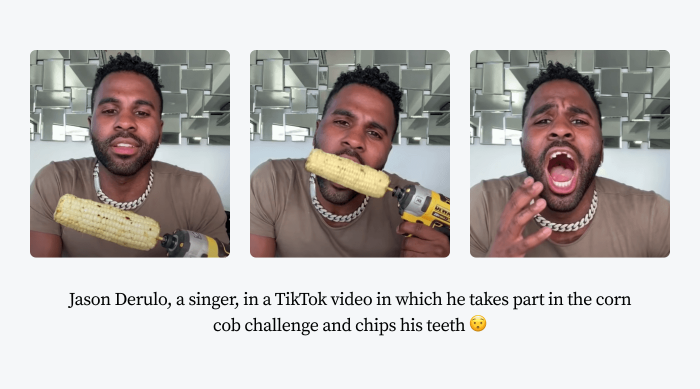
9. Dry scoop challenge
The dry scoop challenge is pretty simple. You take a scoop of dry pre-workout powder and try to it eat without water. The results are similar to the once viral “cinnamon challenge” and can lead to choking and suffocation. The powder can seriously damage your throat and esophagus, and it may also get into your lungs and cause respiratory problems. The rapid caffeine intake (it’s one of the main ingredients) can also be dangerous. One famous case of “dry scooping” involving a popular social media influencer cost her a heart attack and hospitalization.

These are just a few of the dangerous trends and challenges that have been sweeping across TikTok. Right now, the platform tries to moderate these trends and challenges by removing videos that show people participating in them. However, it’s only a matter of time before another dangerous trend or challenge pops up.
Thankfully, some of the “deadliest” challenges on TikTok turned out to be hoaxes.
Did you know?
The “Momo Challenge” was a hoax that circulated online as an urban legend. It was rumored that children and adolescents were being encouraged to perform dangerous tasks, such as violent attacks and suicide, by a user named Momo. However, although there were some complaints about the challenge, there is no evidence that anyone was harmed as a direct result of it.
Key takeaway
For online marketers, TikTok is a powerful way to connect with potential customers and grow their businesses. It’s an extremely popular platform with predominantly young users, which makes it an ideal place to connect with highly active and engaged audiences.
There are many reasons why people enjoy using TikTok, but it’s also highly addictive. Many users have reported feeling compelled to spend hours on the app, mindlessly scrolling through videos. This poses many ethical questions and concerns.
It’s also worth remembering that TikTok is a platform where users can share videos of themselves participating in various challenges and trends. While many of these challenges are harmless, some of them can be dangerous. Make sure to stay safe.
Sources:
- How Frustration Over TikTok Has Mounted in Washington
- A Third of Tiktok’s U.S. Users May Be 14 or Under, Raising Safety Questions
- TikTok to Surpass YouTube in Us—and Come After Other Apps in the Process
- The Bogus “Momo Challenge” Internet Hoax, Explained
- TikTok Says 1 Billion People Use the App Each Month
- Association Between Social Media Use and Self-Reported Symptoms of Depression
- TikTok Publishes New Report on the Capacity to Drive Offline Sales via TikTok Ads
- Teens, Social Media and Technology 2022
- TikTok Revenue and Usage Statistics (2022)
- Essential TikTok Statistics and Trends for 2022
- TikTok by the Numbers: Stats, Demographics & Fun Facts
- TikTok Statistics – Updated Aug 2022
- The Power of Short Form Video
Methodology
New statistics that are not cited from the reports listed in the sources above come from our original study. We surveyed 1,129 participants who answered a set of questions. The survey was available on social media, such as Reddit, and on MTurk. The makeup of the audience, the sample size, and the overlap of the responses with the results of existing studies suggest that the results can be extrapolated to the majority of English-speaking internet users in general.
Since the respondents’ experience is subjective and some of the questions required self-assessment, we acknowledge that some of the answers might have been subject to such cognitive biases as recency, attribution, or exaggeration.
Fair Use Statement
Has our research helped you learn more about emerging TikTok trends or potential dangers of using the platform? Feel free to share the statistics from our study. Just remember to mention the source and include a link to this page. Thank you!

